Our panga motored to within a few feet of a nondescript crescent beach backed by jagged, guano-encrusted cliffs. Its unremarkable appearance didn’t temper my excitement, for this was Darwin Bay on the island of Genovese in the Galapagos Islands, one of the most iconic natural destinations in the world. I hopped out into calf-high water and followed our naturalist up the sand trail and into an arid landscape of prickly pear cactus and dense mangroves. Balls of brilliant white fluff peered out from nests that were little more than vague piles of sticks heaped in the mangrove roots. Juvenile Great Frigatebirds, Nazca Boobies and the rarer Red-Footed Boobies examined us with curiosity but made no attempt to flee or even hide, though they were close enough to reach out and touch. Galapagos Doves with red feet and startlingly blue eyes hopped around on the ground, indifferent to our intrusion. On the rocks, pairs of Swallow-Tailed Doves trained red-ringed eyes on us as they preened, and Yellow-Crowned Herons stilt-walked through iridescent turquoise tidal pools.
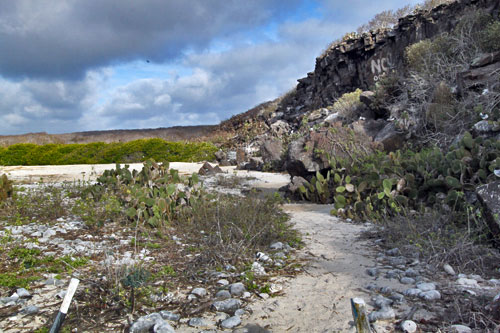
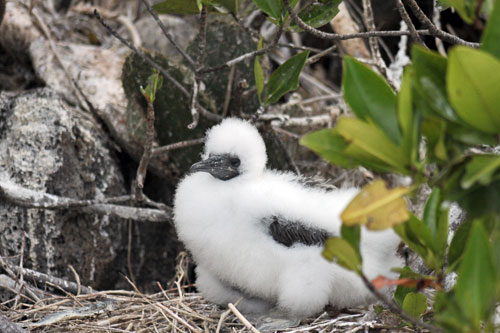
The Galapagos Islands are famous as the place where Charles Darwin developed the theory of evolution by natural selection during his voyage aboard the HMS Beagle in 1861-65, but they enjoy a near mythical status as a sanctuary for exotic animals that have never learned to fear humans. Indeed, during our walks around Genovese and on every subsequent visit to other islands in the archipelago, the animals seemed completely unruffled by our presence. Piles of marine iguanas basked in the sun, paying no heed as we squatted down to film them spitting excess salt from their bodies. Ages-old mating rituals were performed, as if for our pleasure: Male Magnificent Frigatebirds puffed up a red sack around their gullet and spread their immense wings, while Blue-Footed Boobies raised their colorful feet in a dance designed to woo females. One afternoon we spotted an enormous Short-Eared Owl napping in a lava crevice; as we gawped he perused us through yellow slitted eyes, raised one giant claw to scratch, then nonchalantly went back to sleep. Sea lions frolicked with us and marine turtles munched on seagrass as we snorkeled. Even the schools of tiny silver fish, who turn collectively as if sharing a single consciousness, seemed less skittish in the Galapagos, daring to touch my extended hand.

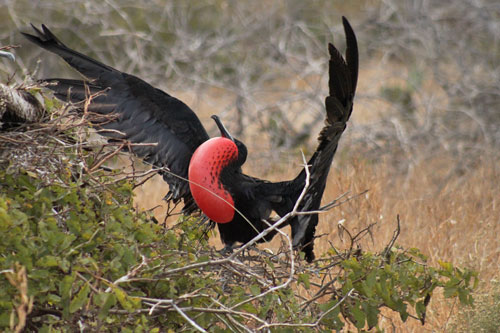
Prior to arriving in the Galapagos I believed that its animals were unafraid because they had never been threatened by man. My assumption could not have been more incorrect. In 1535, Fray Tomas de Berlanga, a missionary whom the King of Spain had named Bishop of Panama, was sailing home to inform the king about lands recently conquered from the Incas. Off the coast of what is now Colombia, they were becalmed and forced to drift with the currents. On March 10 land was finally sighted; they had discovered the Galapagos. Berlanga later provided His Majesty with the first written account of the islands:
“…since the ship had only enough water for two days, it was agreed to lower a boat and go ashore for water and grass for the horses, once ashore, nothing more was found but sea lions and turtles and tortoises so large that each could carry a man on top of itself, and many iguanas that are like serpents. On a second island, there were the same conditions as on the first (…) many birds like those from Spain, but so silly that they didn’t know how to flee, and many were caught by hand…”
Man, the greatest predator the Galapagos have ever known, had arrived.
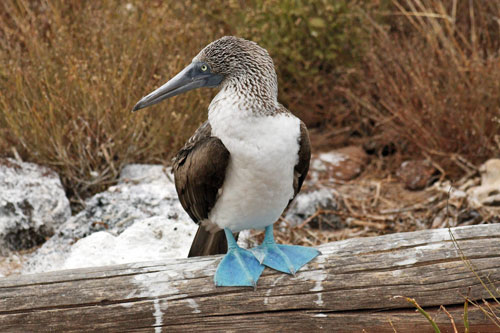
During the 17th and 18th centuries, the Galapagos were a refuge for buccaneers who discovered, as did the sailors of the day, that the slow-moving, defenseless tortoises were an ideal source of food. In his Journal of a Cruise Made to the Pacific Ocean in the years 1812-14, Captain David Porter of the U.S. Navy recorded the following in the journal of the frigate Essex:
“But hideous and disgusting as is their appearance, no animal can possibly afford a more wholesome, luscious, and delicate food than they do; the finest green turtle is no more to be compared to them in point of excellence, than the coarsest beef is to the finest veal; and after once tasting the Gallipagos tortoises, every other animal feed fell greatly in our estimation…But what seems the most extraordinary in this animal, is the length of time that it can exist without food; for I have been well assured, that they have been piled away among the casks in the hold of a ship, where they have been kept eighteen months, and when killed at the expiration of that time, were found to have suffered no diminution in fatness or excellence.”
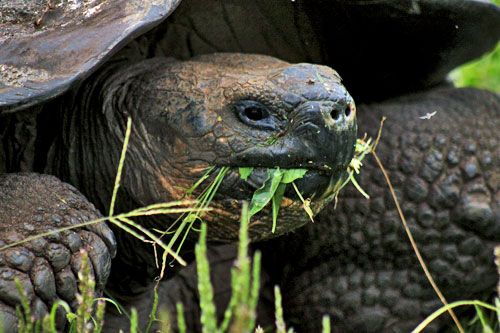
From the time of the buccaneers until colonization, tortoises were hunted mercilessly (a study of whalers’ logbooks suggests that a minimum of 100,000 tortoises were taken by North American whalers alone), but even colonization did not mute the slaughter. Ecuador proclaimed their ownership of the islands in February of 1832 and settlements immediately sprung up; over the ensuing years, resources of the Galapagos were exploited with renewed fervor: fur seals were killed for their skins; a particular variety of lichen was collected for the manufacture of dyes; Sea Cucumbers, prized as an aphrodisiac in the orient, were decimated. Tortoises did not escape this latest round of profiteering. The demand for turtle meat was replaced by a market for their oil, which was used in street lamps and to light homes in Guayaquil until the 1930’s.
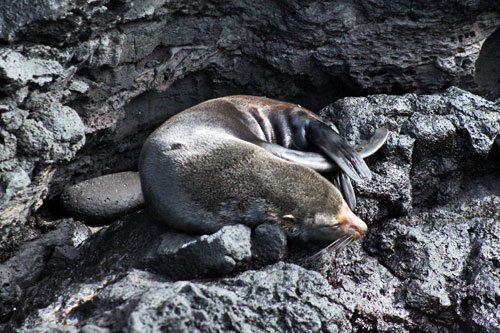
Charles Darwin may be the world’s most famous naturalist but it was the efforts of another, William Beebe, that finally alerted the world to the negative impact of humans on the Galapagos. In 1923, as director of the department of tropical research for the New York Zoological Society, Bebee led an expedition to the Galapagos to find clues to how evolution worked. The biggest change in the environment between the visits of Darwin and Beebe was the virtual disappearance of the tortoise population. In his celebrated work, On the Origin of Species, Darwin describes the tortoises as being present in great numbers on all islands of the archipelago but Beebe’s saw only one tortoise during his visit; by 1906 two of the fifteen known species of tortoises were extinct, one was nearly extinct, three were very rare, and three were rare. By the 1970’s only 3,000 giant tortoises remained of the estimated 250,000 that had once roamed the islands.
The collection of specimens brought back by Bebee for display at the New York Zoological Society, as well as his travel book, Galápagos: World’s End, which remained on the New York Times Best Seller list for ten months, ignited interest in conservation and preservation of Galapagos wildlife. Galapagos National Park, which today controls 97% of the land area in the archipelago, was created by the Ecuadorian government in 1959 and the first park rangers arrived a few years later. Quotas on tourist numbers were put in place and stringent new rules prohibited visitors from touching or even approaching within six feet of the animals. In the same year, the Charles Darwin Foundation was founded and, in tandem with the National Park, it has been instrumental in stabilizing the ecosystem of the Galapagos. By virtue of their joint efforts, the tortoise population is rebounding, a land iguana restoration program has been initiated, invasive species are being eradicated, and a number of endemic and indigenous species previously thought to be extinct have been rediscovered.
Can’t view the above slide show of the Galapagos Islands in Ecuador? Click here.
Though Galapagos wildlife is no longer threatened by man, considering the history of human abuse, the animals’ lack of fear is nothing short of miraculous. I asked Cecibel Guerrero, one of the naturalists who accompanied our group on board Ecoventura’s yacht, for an explanation. “The animals that were hunted by man were the tortoises and fur sea lions…(even today) if you want a picture with the tortoise´s head out of its shell, you have to be very slow and quiet. The same thing happens with the fur sea lions, sometimes we find them in the water when we go snorkeling and as soon as we jump into the water they come out. As for the rest of the animals, they are naive and do not fear man because we have always kept our distance from them.”
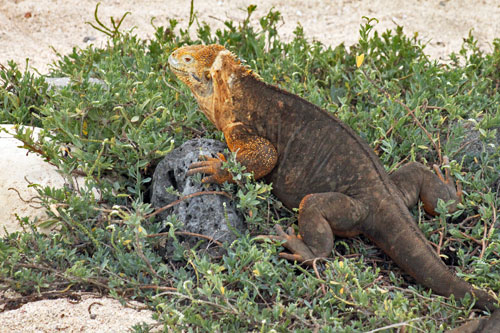
Still, that does not completely explain the boldness of most Galapagos species. Even the land iguanas of North Seymour Island, which were hunted to near extinction and used to hide when humans came around, have lost their fear over the last few years. They munched unconcernedly on beach vegetation as we gathered ‘round, snapping photos. And certainly there are places on the earth that are equally remote as the Galapagos – the jungles of Borneo and the heart of the Amazon come to mind – where human intervention has always been minimal, yet animals in those places keep their distance.
The myth that animals of the Galapagos are unafraid because they have never been threatened by humans has been thoroughly debunked, but the greater mystery of why they are so fearless remains. Perhaps we shall never know why, but let us hope that it always remains so.
Ecoventura kindly hosted the author’s visit to the Galapagos in Ecuador. However, the receipt and acceptance of complimentary items/services received will never influence the content, topics, or posts in this blog. I write the truth, the whole truth, and nothing but the truth. In this case, I highly recommend Ecoventura, not only for their excellent facilities and the smaller, intimate size of their yachts, but also for their devotion to conservation, which included hiring two of the best naturalists I have ever had the pleasure to work with, Cecibel Guerrero and Yvonne Mórtola.

Naturalistic place. Incredible!!! Congratulations to the artists!!!
Thanks for sharing this post. Really it’s a gem island nice
place for tourists. Moreover, I would also recommend you to visit Virginia,
Luray and explore its attractions.
Great article. I think mankind is finally starting to understanding the importance of saving and preserving the wildlife of the world (though too late for many and leaving a fight for many others). To think what we did to such wonderful species as whales and giant tortoises is a humbling lesson hopefully heeded by our future generations.
You’ve captured some beautiful photos here Barbara, it looks like an incredible place. I’m always looking for new ideas for places to go, and this inspires me to go to the Galapagos Islands, thank you very much
Excellent article. I have been to the Galapagos, but this article adds more depth and color. Truly enjoyable.
Luisa A.
Thanks Larellano – I did a lot of research on this article so makes me very happy that you enjoyed it. And thanks to everyone else who left me such lovely comments. Going to the Galapagos was truly a dream come true.
no words…just awesome…….
This place is insanely beautiful, the nature is so stunning! If I go there, I would never want to go back!
After reading this post, i really wish to visit this beautiful and attractive island…
Again, like so often, I learn something reading your well researched articles. I didn’t know it was a myth that the animals were never threatened by humans. Maybe there’s really ‘something in the air’ that triggers their behavior? Just a ‘wild’ guess 😉 A few years ago a read a report that tried to explain the difference between people’s characters in different cities of the same small country. It was explained with higher levels of certain chemical compounds that were present in much higher levels in one area compared to others (unfortunately, I forgot exactly what kind of ‘chemical components’).
I skipped the Galapagos when I was in Ecuador almost one year ago. The more pictures I see makes me think I might need to fit it in when I head back up through South America.
You beat me there! The islands are as fabulous as I’d heard. I’ll be crossing them off my bucket list soon. Thanks for the write-up.
It sounds like a naturalist’s paradise, to be able to get so close to all these animals without having to get out the binos – they are more colourful than I imagined too
Galapagos looks – and sounds – like such a beautiful and special place, Barbara.
YES This is very natural place.